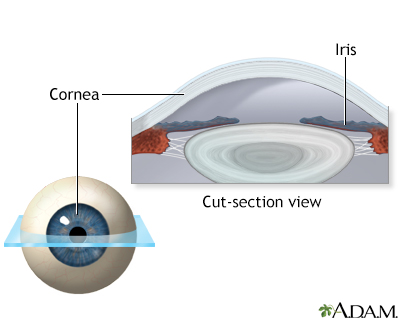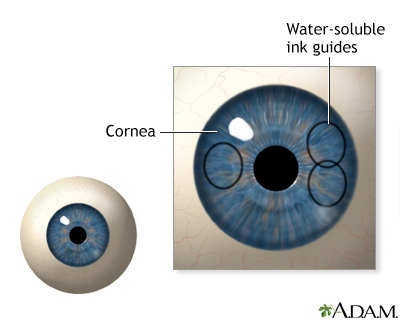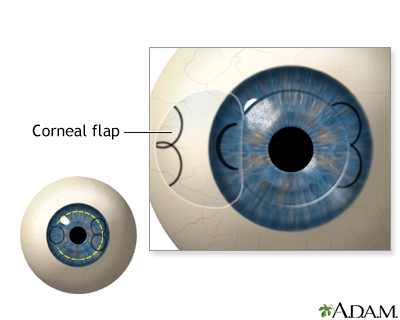Refractive corneal surgery - what to ask your doctor
What to ask your doctor about refractive eye surgery; Nearsightedness surgery - what to ask your doctor; LASIK - what to ask your doctor; Laser-assisted in situ keratomileusis - what to ask your doctor; Laser vision correction - what to ask your doctor; PRK - what to ask your doctor; SMILE - what to ask your doctorRefractive eye surgery helps improve nearsightedness, farsightedness, and astigmatism. Below are some questions you may want to ask your health care provider.
Nearsightedness
Nearsightedness is when light entering the eye is focused incorrectly. This makes distant objects appear blurred. Nearsightedness is a type of refr...

Farsightedness
Farsightedness is having a harder time seeing objects that are close than things that are far away. The term is often used to describe the need for r...

Astigmatism
Astigmatism is a type of refractive error of the eye. Refractive errors cause blurred vision. They are the most common reason why a person goes to ...

Questions
Will this surgery help my type of vision problem?
- Will I still need glasses or contact lenses after the surgery?
- Will it help with seeing things that are far away? With reading and seeing things close up?
- Can I have surgery on both eyes at the same time?
- How long will the results last?
- What are the risks of having the surgery?
- Will the surgery be done with the latest technology?
How do I prepare for this surgery?
- Do I need a physical exam by my regular health care provider before the surgery?
- Can I wear my contact lenses before the surgery?
- Can I use makeup?
- What if I am pregnant or nursing?
- Do I need to stop taking my medicines beforehand?
What happens during the surgery?
- Will I be asleep or awake?
- Will I feel any pain?
- How long will the surgery last?
- When will I be able to go home?
- Will I need someone to drive for me?
How do I take care of my eyes after surgery?
- What type of eye drops will I use?
- How long will I need to take them?
- Can I touch my eyes?
- When can I take a shower or bath? When can I swim?
- When will I be able to drive? Work? Exercise?
- Are there any activities or sports that I will not be able to do after my eyes are healed?
- Will the surgery cause cataracts?
What will it be like right after surgery?
- Will I be able to see?
- Will I have any pain?
- Are there any side effects I should expect to have?
- How soon will it be before my eyesight gets to its best level?
- If my vision is still blurry, will more surgery help?
Do I need any follow-up appointments?
For what problems or symptoms should I call the provider?
References
American Academy of Ophthalmology website. Questions to ask when considering LASIK. www.aao.org/eye-health/treatments/lasik-questions-to-ask. Updated April 29, 2023. Accessed August 22, 2024.
Asroui L, Chong JK, Randleman JB. Preoperative evaluation for refractive surgery. In: Yanoff M, Duker JS, eds. Ophthalmology. 6th ed. Philadelphia, PA: Elsevier; 2023:chap 3.2.
Mercer RN, Waring GO, Rocha KM. Current concepts, classification, and history of refractive surgery. In: Yanoff M, Duker JS, eds. Ophthalmology. 6th ed. Philadelphia, PA: Elsevier; 2023:chap 3.1.
Turbert D. What is small incision lenticule extraction. American Academy of Ophthalmology website. www.aao.org/eye-health/treatments/what-is-small-incision-lenticule-extraction. Updated May 17, 2023. Accessed August 22, 2024.
Lasik eye surgery - series - Normal anatomy
Presentation
Normal, nearsightedness, and farsightedness - illustration
Normal vision occurs when light is focused directly on the retina rather than in front or behind it. A person with normal vision can see objects clearly near and faraway. Nearsightedness results in blurred vision when the visual image is focused in front of the retina, rather than directly on it. It occurs when the physical length of the eye is greater than the optical length. For this reason, nearsightedness often develops in the rapidly growing school-aged child or teenager, and progresses during the growth years, requiring frequent changes in glasses or contact lenses. A nearsighted person sees near objects clearly, while objects in the distance are blurred. Farsightedness is the result of the visual image being focused behind the retina rather than directly on it. It may be caused by the eyeball being too small or the focusing power being too weak. Farsightedness is often present from birth, but children can often tolerate moderate amounts without difficulty and most outgrow the condition. A farsighted person sees faraway objects clearly, while objects that are near are blurred.
Normal, nearsightedness, and farsightedness
illustration
Lasik eye surgery - series - Normal anatomy
Presentation
Normal, nearsightedness, and farsightedness - illustration
Normal vision occurs when light is focused directly on the retina rather than in front or behind it. A person with normal vision can see objects clearly near and faraway. Nearsightedness results in blurred vision when the visual image is focused in front of the retina, rather than directly on it. It occurs when the physical length of the eye is greater than the optical length. For this reason, nearsightedness often develops in the rapidly growing school-aged child or teenager, and progresses during the growth years, requiring frequent changes in glasses or contact lenses. A nearsighted person sees near objects clearly, while objects in the distance are blurred. Farsightedness is the result of the visual image being focused behind the retina rather than directly on it. It may be caused by the eyeball being too small or the focusing power being too weak. Farsightedness is often present from birth, but children can often tolerate moderate amounts without difficulty and most outgrow the condition. A farsighted person sees faraway objects clearly, while objects that are near are blurred.
Normal, nearsightedness, and farsightedness
illustration
Review Date: 8/5/2024
Reviewed By: Franklin W. Lusby, MD, Ophthalmologist, Lusby Vision Institute, La Jolla, CA. Also reviewed by David C. Dugdale, MD, Medical Director, Brenda Conaway, Editorial Director, and the A.D.A.M. Editorial team.











